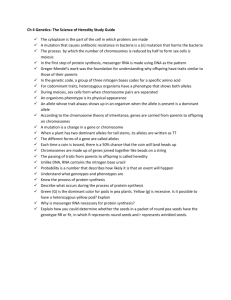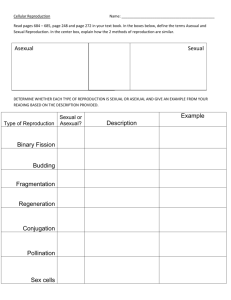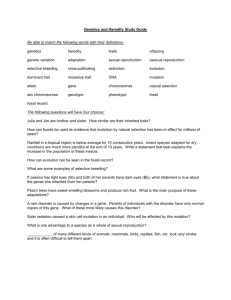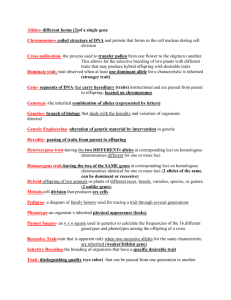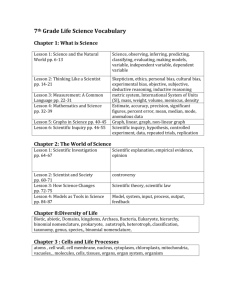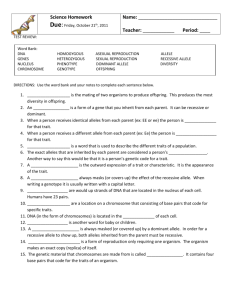7th Grade Science * Unit 2 *Genetics
advertisement
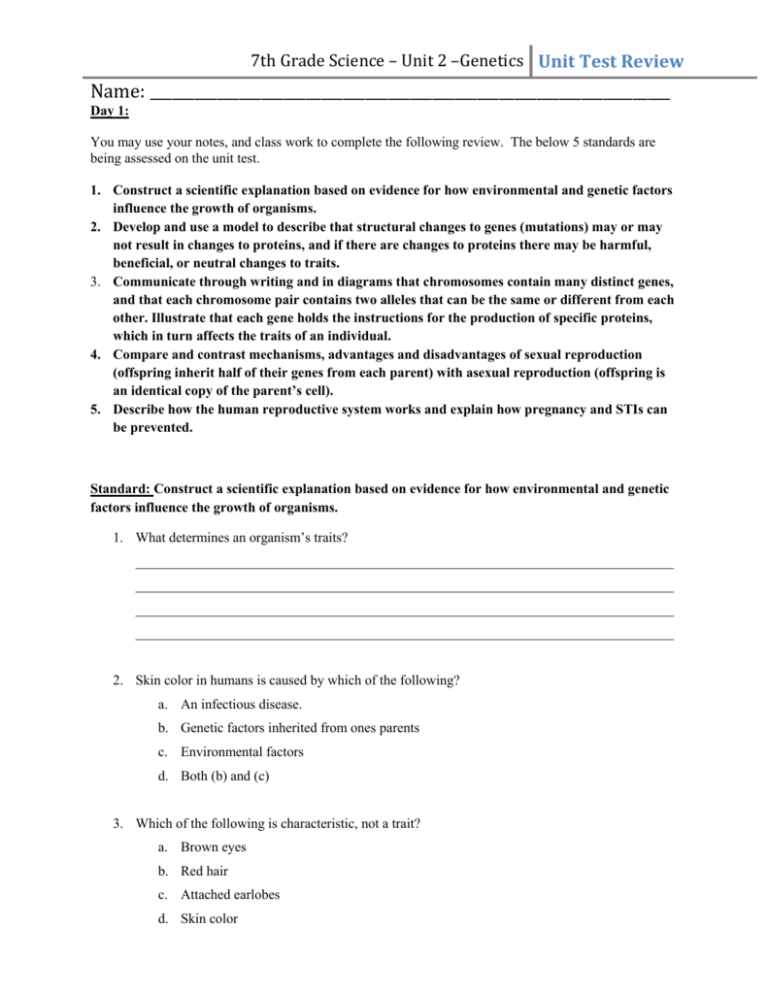
7th Grade Science – Unit 2 –Genetics Unit Test Review Name: ______________________________________________________________________ Day 1: You may use your notes, and class work to complete the following review. The below 5 standards are being assessed on the unit test. 1. Construct a scientific explanation based on evidence for how environmental and genetic factors influence the growth of organisms. 2. Develop and use a model to describe that structural changes to genes (mutations) may or may not result in changes to proteins, and if there are changes to proteins there may be harmful, beneficial, or neutral changes to traits. 3. Communicate through writing and in diagrams that chromosomes contain many distinct genes, and that each chromosome pair contains two alleles that can be the same or different from each other. Illustrate that each gene holds the instructions for the production of specific proteins, which in turn affects the traits of an individual. 4. Compare and contrast mechanisms, advantages and disadvantages of sexual reproduction (offspring inherit half of their genes from each parent) with asexual reproduction (offspring is an identical copy of the parent’s cell). 5. Describe how the human reproductive system works and explain how pregnancy and STIs can be prevented. Standard: Construct a scientific explanation based on evidence for how environmental and genetic factors influence the growth of organisms. 1. What determines an organism’s traits? ______________________________________________________________________________ ______________________________________________________________________________ ______________________________________________________________________________ ______________________________________________________________________________ 2. Skin color in humans is caused by which of the following? a. An infectious disease. b. Genetic factors inherited from ones parents c. Environmental factors d. Both (b) and (c) 3. Which of the following is characteristic, not a trait? a. Brown eyes b. Red hair c. Attached earlobes d. Skin color 7th Grade Science – Unit 2 –Genetics Unit Test Review Name: ______________________________________________________________________ 4. Traits are influenced by nature and by nurture. Describe what each of these terms mean and give an example of a trait that is influenced by each. ______________________________________________________________________________ ______________________________________________________________________________ ______________________________________________________________________________ ______________________________________________________________________________ ______________________________________________________________________________ ______________________________________________________________________________ ______________________________________________________________________________ ______________________________________________________________________________ Standard: Develop and use a model to describe that structural changes to genes (mutations) may or may not result in changes to proteins, and if there are changes to proteins there may be harmful, beneficial, or neutral changes to traits. 1) What is the possible outcome of a mutation in a body cell? a. Cell death b. Cancer c. No observable change d. All of the above 2) Describe how mutations can affect proteins in the body: ______________________________________________________________________________ ______________________________________________________________________________ ______________________________________________________________________________ ______________________________________________________________________________ ______________________________________________________________________________ 3) Given the following string of DNA – AATTCGC a. Rewrite it with a mutation _______________________________ 4) Given an example and description of each of the following: a. Harmful mutation ________________________________________________________________________ ________________________________________________________________________ ________________________________________________________________________ b. Beneficial mutation ________________________________________________________________________ ________________________________________________________________________ ________________________________________________________________________ c. Neutral mutation ________________________________________________________________________ 7th Grade Science – Unit 2 –Genetics Unit Test Review Name: ______________________________________________________________________ ________________________________________________________________________ ________________________________________________________________________ 5) What is the difference between a mutation in a sex cell and a mutation in a somatic cell? ______________________________________________________________________________ ______________________________________________________________________________ ______________________________________________________________________________ ______________________________________________________________________________ ______________________________________________________________________________ ______________________________________________________________________________ Day 2 Standard: Communicate through writing and in diagrams that chromosomes contain many distinct genes, and that each chromosome pair contains two alleles that can be the same or different from each other. Illustrate that each gene holds the instructions for the production of specific proteins, which in turn affects the traits of an individual. 1. Describe the function of proteins in the body: ______________________________________________________________________________ ______________________________________________________________________________ ______________________________________________________________________________ ______________________________________________________________________________ _____________________________________________________________________________ 2. Define and give an example of: a. Incomplete dominance: ________________________________________________________________________ ________________________________________________________________________ ________________________________________________________________________ ________________________________________________________________________ b. Co-dominance: ________________________________________________________________________ ________________________________________________________________________ ________________________________________________________________________ ________________________________________________________________________ 3. Which of the following is not an example of co-dominance? a. Parents with Type A and Type B blood, produce an offspring with type AB blood. b. A dog with a brown parent and a black parent has patches ofbrown and black fur. c. A red flowered plant and white flowered plant produce a pink flowered plant. 7th Grade Science – Unit 2 –Genetics Unit Test Review Name: ______________________________________________________________________ d. A critter with two red spikes and critter with three green spikes produces a critter with 5 spikes (some green, some red) 4. How many people have the same exact DNA as you (assuming that you are not an identical twin)? a. 1 b. 0 c. 12 d. Millions 5. What is the purpose of chromosomes? ______________________________________________________________________________ ______________________________________________________________________________ ______________________________________________________________________________ 6. What are chromosomes made of? ________________ 7. Where are chromosomes stored? ___________________ 8. DNA is made up of 4 different bases: Adenine, Cytosine, Thymine, and Guanine. Each of these bases pair up with one other base. Write the 2 possible base pairs: ______________________________________________________________________________ 9. 10. 11. 12. 13. 14. Given: “B” is dominant for blue color and “b” is recessive for yellow color. What flower color genotype would yield a yellow phenotype? _____________________ Give an example of heterozygous alleles: __________ Give an example of homozygous dominant alleles: ___________ Give an example of homozygous recessive alleles: __________ Where is the DNA stored? ________________________ Give an example of 2 things that can and 2 things that cannot be determined by studying an organism’s chromosomes. ______________________________________________________________________________ ______________________________________________________________________________ ______________________________________________________________________________ ______________________________________________________________________________ 15. Order the following from smallest to largest: chromosomes, cells, DNA ________________________________________________________________________ 16. Why do we say there are 23 pairs of chromosomes in a human body cell? ______________________________________________________________________________ ______________________________________________________________________________ ______________________________________________________________________________ ______________________________________________________________________________ 7th Grade Science – Unit 2 –Genetics Unit Test Review Name: ______________________________________________________________________ 17. When a homozygous recessive individual is crossed with a homozygous dominant individual, what is the probability that the offspring will display the dominant trait? a. 100% b. 0% c. 50% d. 75% 18. Given the following Punnett Square, write in the genotypes of the parents: Hh hh HH hH 19. What is Mendel’s ratio of dominant to recessive when two heterogeneous organisms are breed? ___________________ 20. Using the below pedigree to determine the possible genotypes of specific family members and explain your reasoning for each: 1 2 1 3 1 4 1 a. Person 1 ________________________________________________________________ ________________________________________________________________________ ________________________________________________________________________ b. Person 2 ________________________________________________________________ ________________________________________________________________________ ________________________________________________________________________ c. Person 3 ________________________________________________________________ ________________________________________________________________________ ________________________________________________________________________ d. Person 4________________________________________________________________ ________________________________________________________________________ ________________________________________________________________________ 7th Grade Science – Unit 2 –Genetics Unit Test Review Name: ______________________________________________________________________ Standard: Compare and contrast mechanisms, advantages and disadvantages of sexual reproduction (offspring inherit half of their genes from each parent) with asexual reproduction (offspring is an identical copy of the parent’s cell). 1. When looking at a human karyotype, a scientist notices identifies both an X chromosome and a Y chromosome. What does this information tell the scientist? a. The individual is male. b. The individual carries the recessive allele for a rare disease. c. The individual is female d. The individual is dominant for all traits. 2. Why do individuals have two alleles for each gene? a. It works better that way b. One allele comes from each parent c. In case there is a mutation in one allele d. Who knows? 3. Sex cells have how many chromosomes in relation to the number in body cells? a. Twice as many. b. One half as many. c. Four times as many. d. One fourth as many. 4. Which is not an example of asexual reproduction? a. A plant sends out runners with baby plants attached b. Pollen from one plant lands on the stigma of another plant which creates seeds c. A paramecium undergoes cell division d. Yeast buds. 5. One disadvantage of asexual reproduction is: a. The ability to reproduce rapidly and prolifically. b. The ability to make offspring identical to the parent. c. The lack of genetic diversity in the population. d. The low cost of reproduction. 6. Give 3 examples of organisms that reproduce sexually: ________________________________________________________ 7th Grade Science – Unit 2 –Genetics Unit Test Review Name: ______________________________________________________________________ ________________________________________________________ ________________________________________________________ 7. Give 3 examples of organisms that reproduce asexually: ________________________________________________________ ________________________________________________________ ________________________________________________________ 8. Fill in the chart: Sexual Asexual Advantages Disadvantages In sexual reproduction, what percentage of the offspring’s genetic material comes from each parent? ______________ 10. In asexual reproduction, what percentage of the offspring’s genetic material comes from the parent? ______________ 11. Each body cell in a rat contains 102 chromosomes. How many chromosomes are contained in a rat sex cell? __________________ 12. Blood cells reproduce asexually. Can you tell the difference between the parent cell and the 9. offspring? _________________ Why or why not?_____________________________________ ______________________________________________________________________________ ______________________________________________________________________________ 13. Mitosis or Meiosis … which is sexual, which is asexual? How will you remember? ______________________________________________________________________________ ______________________________________________________________________________ ______________________________________________________________________________ ______________________________________________________________________________ Day 3 Standard: Describe how the human reproductive system works and explain how pregnancy and STIs can be prevented. 1. Give 2 examples of contraception and explain how each prevents pregnancy. ______________________________________________________________________________ ______________________________________________________________________________ 7th Grade Science – Unit 2 –Genetics Unit Test Review Name: ______________________________________________________________________ ______________________________________________________________________________ ______________________________________________________________________________ 2. Give 2 examples of STI’s and explain the treatment, prevention, and symptoms of each. ______________________________________________________________________________ ______________________________________________________________________________ ______________________________________________________________________________ ______________________________________________________________________________ ______________________________________________________________________________ ______________________________________________________________________________ ______________________________________________________________________________ ______________________________________________________________________________ ______________________________________________________________________________ ______________________________________________________________________________ ______________________________________________________________________________ 3. Why is communication necessary for a healthy relationship? ______________________________________________________________________________ ______________________________________________________________________________ ______________________________________________________________________________ ______________________________________________________________________________ ______________________________________________________________________________ ______________________________________________________________________________ ______________________________________________________________________________ 4. What is an abusive relationship? What are the types of abuse? ______________________________________________________________________________ ______________________________________________________________________________ ______________________________________________________________________________ ______________________________________________________________________________ ______________________________________________________________________________ ______________________________________________________________________________ ______________________________________________________________________________ ______________________________________________________________________________ 7th Grade Science – Unit 2 –Genetics Unit Test Review Name: ______________________________________________________________________ 5. Label each of the diagrams. 7th Grade Science – Unit 2 –Genetics Unit Test Review Name: ______________________________________________________________________ 6. Use the diagrams to describe the path of the sperm and the path of the egg. ______________________________________________________________________________ ______________________________________________________________________________ ______________________________________________________________________________ ______________________________________________________________________________ ______________________________________________________________________________ ______________________________________________________________________________ ______________________________________________________________________________ ______________________________________________________________________________ ______________________________________________________________________________ ______________________________________________________________________________ ______________________________________________________________________________ ______________________________________________________________________________ ______________________________________________________________________________ ______________________________________________________________________________ ______________________________________________________________________________ ______________________________________________________________________________ 7. What happens after an egg is fertilized? ______________________________________________________________________________ ______________________________________________________________________________ ______________________________________________________________________________ ______________________________________________________________________________
